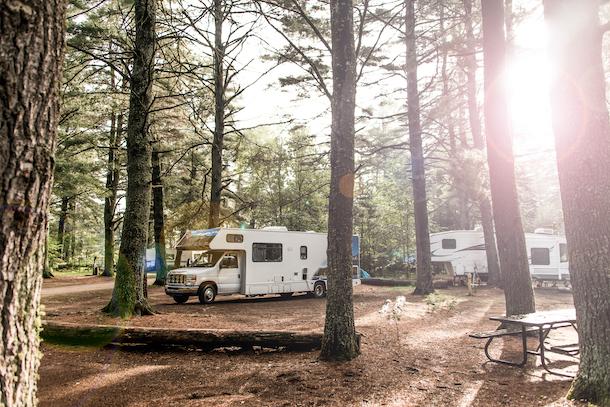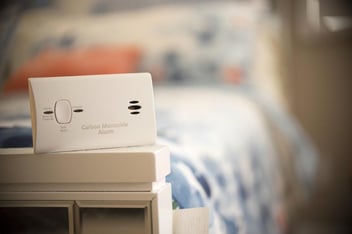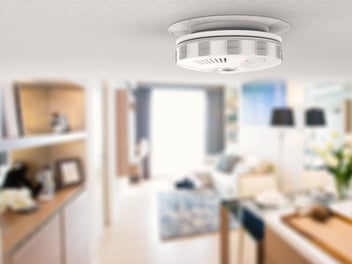As you prepare to pack for your summer vacation this year, it’s important to remember one small but potentially life-saving travel item that often gets overlooked: a portable carbon monoxide alarm.
Carbon monoxide (CO) is a colourless, tasteless, and odourless gas. It's known as the “silent killer” and is produced when gasoline, oil, kerosene, natural gas, wood, or propane burns incompletely. Symptoms of CO poisoning include headaches, dizziness, nausea, seizures, coma, and death.
While the risk of CO exposure is often thought of as being associated with fuel burning appliances in older homes, with faulty furnaces, stoves, and water heaters, CO is also a risk away from home. Whether you’re camping, boating, staying in a vacation rental, or traveling by RV, the risk of CO may be present.
According to the BC Coroners Service, there have been 118 carbon monoxide poisoning deaths in the province since 2012, including nine in 2021 and eight in 2022. As a safety regulator, preventing CO exposure is one of our highest priorities, and consistently tops our list of safety risks in the province. The best way to detect the presence of carbon monoxide is with a CO alarm.
What is a Portable CO Alarm?
When you're on vacation, no matter where you’re planning to rest your head for the night, it's a good idea to bring a portable CO alarm with you. These devices can detect CO in the air and sound an alarm if they detect a dangerous level. They are small, lightweight, and easy to pack in your suitcase, backpack, or carry-on bag. They are also relatively inexpensive, and most alarms have a battery life of up to ten years. Make sure to pack the alarm in an easily accessible location, like your carry-on bag or your car's glove compartment.
When you arrive at your vacation rental, you’ll want to place your alarm at head height, on each floor where gas appliances are located, preferably near where you’ll be sleeping. For example, this can be on a bookshelf or bedside table.
If you're camping in a tent, you can place your alarm on the tent floor or inside an unenclosed mesh pocket. There are also some CO alarm models available that include a cord or hook to allow you to hang them from the ceiling of your tent or RV. Be sure to follow the manufacturer’s instructions when determining how and where to place your CO alarm.
What to Do if Your CO Alarm Goes Off
If your CO alarm goes off, do not ignore or remove the alarm from the space. Instead, get everyone out of the space, including pets, go outside, and call the local emergency services. Do not re-enter the space until you have been given the all-clear from first responders. If you believe you’ve been exposed to CO, you should seek medical attention.
After a certain amount of time, CO alarms will expire, and some will emit a chirping sound when the power is low or when its service life has expired. We recommend always testing your CO alarm before your trip.
Sources of CO When You’re Away from Home
Some sources of CO include the following travel and camping equipment:
- Camping stoves: These stoves, often used for cooking in outdoor settings, can emit carbon monoxide if not properly ventilated.
- Portable generators: While convenient for providing power during camping trips, generators that run on gasoline or propane emit CO, which can be hazardous in enclosed spaces.
- Vehicle generators: Similarly, generators in vehicles, such as those used in RVs, can produce carbon monoxide. It's crucial to ensure proper ventilation to prevent CO buildup and to place the generators as per the manufacturer’s installation instructions.
- Gas and propane-powered appliances: Whether it's a portable heater or a hot water heater, appliances that utilize gas or propane have the potential to produce carbon monoxide.
- Propane-fueled water heaters and refrigerators: There are some small gas-fired water heaters and refrigerators that are used when camping, hunting, or in cabins that can pose a risk of carbon monoxide exposure.
- Vehicle exhaust: Exhaust from running vehicles can seep into enclosed spaces, leading to CO exposure. Keep a safe distance from running vehicles.
- RV stoves/ovens/camping stoves: These can create dangerous CO gas if they malfunction and burn gas incompletely. You should have your RV appliances serviced by a licensed shop regularly and never use your camp stove inside an enclosed space.
- Oil-burning space heaters: If you’re using a space heater to warm up, be mindful that they can pose a risk of CO exposure.
The Risk of CO When Camping in a Tent
If the weather suddenly turns on your next camping trip, or nights happen to be colder than you anticipated, don't be tempted to bring your camping stove inside your tent. Levels of CO from the burning stove can build up quickly. Use your stove safely outside your tent in an unenclosed space.
Make sure your tent opening is positioned away from any vehicle exhaust. If you have a rooftop tent on your car, or a trunk-mounted tent, do not run your vehicle or you could easily fill your tent with CO gas.
While these incidents are rare, they do happen. Mitigate the risk by practicing safe behavior and bringing along a portable CO alarm.
RV CO Alarms
Newer models of RVs, such as motor homes and trailers, usually come with an onboard CO alarm. These are often located in the galley. However, if your RV doesn’t have a built-in alarm, you’ll need a portable alarm.
Be sure to test and replace the alarm per the manufacturer’s instructions and replace the batteries (on both hardwired and battery-operated detectors). An easy way to remember to replace batteries is to do it when you head out for the first time each season.
Vacation Rental CO Safety Tips
If you're staying in a vacation rental, like Airbnb on your trip, make sure to choose a listing that has a CO alarm installed. Most modern homes and apartments have them, but it's always a good idea to double-check. Look for a listing that clearly mentions a CO alarm in the amenities section. If the listing doesn't mention an alarm, contact the property owner or manager and ask if one is available. Airbnb requires an alarm in all properties listed, but it doesn’t hurt to check in with your host to ensure that the alarm is installed and operational.
Older vacation rentals, like traditional cabins in remote locations, often run older furnaces and/or propane-fueled appliances, which can pose a greater risk of CO exposure. If you are unable to confirm whether your cabin has a CO alarm installed, you should bring a portable CO alarm to be safe.
In one recent incident that occurred near Ruby Lake, BC, in 2020, two individuals were staying in a recreational cabin built in 1955 equipped with propane-fueled appliances. Over the course of two days, the two occupants were exposed to high levels of carbon monoxide from a propane-run refrigerator. They were discovered inside unresponsive. One occupant was found deceased and the other had to be airlifted to hospital.
In a similar incident that occurred in Tulameen, BC, two individuals were found unresponsive inside a shower building on a recreational property. The building was equipped with a propane-fueled on-demand tankless water heater, which was installed inside a small shower building. The heater vented combustion products into the building where it also received its combustion air supply, producing high levels of carbon monoxide as the combustion air was consumed.
Conclusion
Carbon monoxide exposure is a very serious and potentially life-threatening safety risk that can unfortunately follow us to our favorite vacation destinations. To stay safe on your next trip, be sure to follow our CO safety tips and, of course, pack a portable CO alarm. Have a safe time and enjoy your trip!




